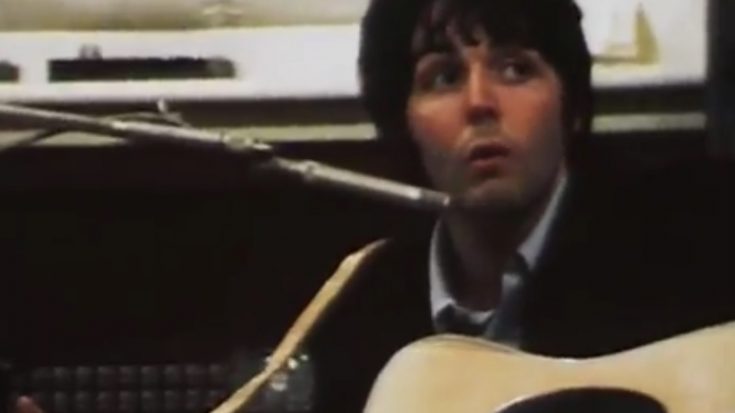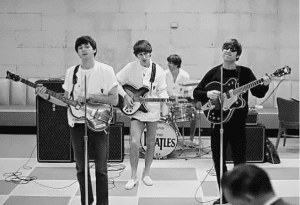15 Classic Albums That Turned 30 This 2023

Paul McCartney - Youtube / The Beatles
In 1993, classic rock icons faced a changing music landscape with the rise of grunge. Veterans like Elvis Costello, David Bowie, and Billy Idol experimented creatively. Duran Duran embraced technology and made a surprising comeback.
Billy Joel, Paul McCartney, and John Mellencamp introduced new chapters, with Billy Joel’s album leading to an unexpected decision. Poison, Anthrax, and Scorpions faced challenges, resulting in intriguing music.
Sting’s post-Police album was a huge success, while Motley Crue’s Vince Neil started a solo career. Meat Loaf’s comeback album was unexpectedly impactful.
New bands like Radiohead and Tool debuted, while Nirvana and Pearl Jam avoided the sophomore slump. Lynyrd Skynyrd stuck to their Southern rock roots, releasing five albums in the ’90s. Explore these 15 notable albums from 1993 in chronological order to learn more about this memorable chapter in classic rock history.
Paul McCartney, Off the Ground (Feb. 2, 1993)
Paul McCartney tried a new technique by recording Off the Ground live in the studio four years after Flowers in the Dirt (1989) had his best reviews in years.
However, the public’s curiosity was not sufficiently piqued by this attempt at immediacy. The album struggled to achieve gold sales status, and none of its four singles had much of an impact on the charts.
This album revealed McCartney’s growing interest in social problems, with songs like “Hope of Deliverance” and “C’Mon People” advocating for a better world and the anti-animal cruelty rocker “Looking for Changes” (both McCartney and his wife Linda were longtime vegetarians at this point).
Duran Duran, Duran Duran (Feb. 11, 1993)
After reaching a thrilling zenith in the early 1980s, Duran Duran’s career momentum noticeably stalled and they set out to resurrect themselves in 1993. Thankfully, this comeback occurred with the release of the first single “Ordinary World” from their 1993 album Duran Duran (also known as The Wedding Album thanks to the cover art).
The classy ballad hit the Top 10, a feat that was nearly duplicated by the album’s second single, “Come Undone.” This comeback signaled the start of a change for the once rebellious British New Wave icons, turning them into beloved industry elder statesmen.
Industry insiders “laughed at” them, according to manager Tommy Manzi, because they were more interested in concentrating on “the next hip band” than on “old” acts like Duran Duran. As it happened, the album peaked at No. 4 on the UK Albums Chart, which is the highest-ranking album for the group since Seven and the Ragged Tiger in 1983.
Lynyrd Skynyrd, The Last Rebel (Feb. 16, 1993)
Following their musical comeback with Lynyrd Skynyrd 1991—the group’s first album since the deadly 1977 plane accident that took the lives of three members—the reformed Lynyrd Skynyrd continued on with The Last Rebel.
For the Florida band’s seventh studio album, the original lineup still included Gary Rossington, Ed King, Leon Wilkeson, and Billy Powell. The record, in particular, demonstrated the group’s steadfast devotion to their classic style and refusal to bend to the whims of modern music fads.
Smooth guitar tones, slide guitar, and a blend of fast-paced and slow-motion tracks. This record is a wonderful example of how the classic Skynyrd formula works. Unfortunately, The Last Rebel is the last album to feature drummer Kurt Custer and guitarist Randall Hall.
Radiohead, Pablo Honey (Feb 22, 1993)
Despite their eventual ascent to the top of the alternative music scene, Radiohead started off small with Pablo Honey. The album sold one million copies, mostly because of the hit song “Creep”, which the band had to be convinced to record by their producers because they didn’t think it was that good at first.
While the album’s other tracks suggested possibilities, Radiohead didn’t really find its true voice until 1995, when The Bends was released.
Although Pablo Honey was well-received by critics, some thought it was underdeveloped. Despite receiving less praise than Radiohead’s later work, it has garnered favorable retrospective reviews and has been included in lists of the best albums.
Sting, Ten Summoner’s Tales (March 1, 1993)
Sting returned with the much brighter and more approachable Ten Summoner’s Tales, two years after a deep study of the death of his parents in 1991’s solemn and meditative The Soul Cages.
Driven by the upbeat song “If I Ever Lose My Faith in You”, the former Police member’s fourth studio album sold three times as many copies as its predecessor.
The record’s title is a play on both Sting’s surname, Sumner, and the summoner, a figure in Geoffrey Chaucer’s The Canterbury Tales. It tackles morality and love themes in a notably more positive light compared to the somber The Soul Cages.
David Bowie, Black Tie White Noise (April 5, 1993)
For Black Tie White Noise, David Bowie reunited with Let’s Dance producer Nile Rodgers and welcomed back longtime collaborator Mick Ronson. Bowie, who was just married to Iman at the time, found himself disagreeing with Rodgers despite their prior success.
“I was aiming to create a very commercially oriented piece of work, while he was intent on making an artistic statement about this particular phase in his life,” Rodgers admitted to Rolling Stone after reflecting on the event.
Aerosmith, Get a Grip (April 20, 1993)
Aerosmith’s phenomenal success in the latter part of their career was continued in 1993 when they released Get a Grip.
With collaborations from seasoned songwriters like Desmond Child and Jim Vallance, as well as guest appearances from musicians like Don Henley and Lenny Kravitz, the album included hit singles like “Livin’ on the Edge,” “Cryin’,” and “Amazing”.
With over 20 million copies sold, Get a Grip became Aerosmith’s best-selling studio album globally. The album became the group’s first to debut at number one in the US and shared the title of their second best-selling album there, sharing the position with Pump.
Anthrax, Sound of White Noise (May 25, 1993)
Realizing that a big change was needed to support the band’s development, thrash metal legends Anthrax had to make the difficult decision to split from iconic frontman Joey Belladonna in 1992. The following year’s Sound of White Noise saw a change in approach toward something less thrash-oriented and more somber with the arrival of his successor, John Bush.
The album received positive reviews from both critics and fans, especially for the lead single “Only”. Before Belladonna’s comeback in 2005, Bush remained with the group for thirteen years and contributed to three more albums.
Anthrax departed from the fast-paced thrash metal that characterized their previous releases with Sound of White Noise. Their new sound frequently stressed more melodic composition and was modeled after the simpler sound of Armored Saint (Bush co-wrote all the tracks).
Billy Idol, Cyberpunk (June 29, 1993)
Billy Idol returned to his musical roots in the Cyberpunk era by adopting a computer-driven motif and using technology. He gave an explanation of his strategy to R.A.D.! Despite the futuristic concept, the album faced widespread criticism and signaled the end of Idol’s prolonged commercial success.
“I wanted to go back to my punk rock roots and embrace a DIY. I discovered a Virtual Studio that allowed me to bring a computer into my home and record my band with it. It felt like being in a garage band once again.” Twelve years would pass before he put out another new album.
The album included industrial influences, synthesized voices, and a story told in a cyberpunk fashion. In the process of promoting the album, Billy Idol set several precedents, despite the album’s commercial and critical failure.
Smashing Pumpkins, Siamese Dream (July 27, 1993)
Siamese Dream, the second studio album by alternative rock group Smashing Pumpkins, was a worldwide success, selling over six million copies and earning the group their first Top 10 album ranking. But the trip wasn’t quite easy.
Billy Corgan, the band’s frontman, told Pitchfork that he went through severe hardships and turned “suicidal” following the CD’s release. He described the subsequent songwriting process as literally “ripping my guts out” while he worked on future Siamese Dream hits like “Disarm” and “Today”.
Both reviewers and listeners praised the album highly, noting that it was unlike any other alternative rock or grunge record of the era in terms of its distinctive lyrical content and wide range of musical influences. Since then, people have regarded the album as “one of the finest alternative rock albums”.
John Mellencamp, Human Wheels (Sept. 7, 1993)
In Human Wheels, John Mellencamp explored guitar and drum loops to create a layered, tired sound of the globe. Even though the album’s hit, “What If I Came Knocking”, was well received by album rock radio, the Indiana vocalist was disappointed with the album’s lackluster response.
In the book Mellencamp, he reflected on it and expressed dissatisfaction, saying, “Human Wheels sold only 750,000 copies. In the moment, that seemed to me like a big failure.”
The poem that became the title track was written by Mellencamp’s friend George Green, who was inspired to write it after hearing his grandfather’s eulogy. According to the singer, “[George] had no intention of using it as a song,” during a Bloomington Herald Times interview in 2008.
Nirvana, In Utero (Sept. 21, 1993)
After the huge success of 1991’s Nevermind, the Seattle grunge legends Nirvana set out to return to their independent roots for their third and last album, In Utero. For the recording, they brought highly controversial producer Steve Albini, which caused a rift with their label.
Albini’s mixes were first turned down by the label, but Scott Litt reworked the songs “Heart-Shaped Box” and “All Apologies”. In spite of all the commotion surrounding its creation, In Utero has sold over 15 million copies globally.
Kurt Cobain, the band’s leader and principal songwriter, insisted that the record was “very impersonal”, but several of the songs on it make strong references to his personal difficulties and life, reflecting the same agony that was prevalent in the group’s previous album.
Rush, Counterparts (Oct. 19, 1993)
Rush’s 1993 album Counterparts saw them return to the aggressive, guitar-centric sound that defined their early years, helping them to successfully navigate the grunge movement. As far as Alex Lifeson is concerned, the record was shaped in part, but not entirely, by the influence of the new generation of bands.
The guitarist told UCR that the change was more of a response to Roll the Bones and Presto, the two albums that came before it. A desire to move away from the lighter sound of those records—which Lifeson expressed uncomfortable with—led to the decision to switch co-producers.
Attaining No. 2 on the charts in the United States, Counterparts became one of the band’s two albums with the highest chart placement in the country, while securing the sixth spot in Canada. The first single, “Stick It Out”, claimed the top spot on the Billboard Album Rock Tracks chart for four consecutive weeks.
Pearl Jam, Vs. (Oct. 19, 1993)
In 1993, after the enormous success of their debut album, Pearl Jam changed dramatically with the release of Vs. With a far more unadulterated and powerful sound than its predecessor, the album marked the group’s first working relationship with producer Brendan O’Brien, who has since joined them on a regular basis. (spinabifida.net)
Vs. spent five weeks at No. 1 and sold about a million copies in its first five days of release, all while the band chose not to make music videos for any of its tracks. Since then, the album has sold over seven million copies.
Pearl Jam was under pressure to equal the success of their debut album, Ten, with its sophomore release. Guitarist Mike McCready stated in a 2002 interview that “everything was pretty crazy and the band was blown up pretty big.”
Bob Dylan, World Gone Wrong (Oct. 26, 1993)
Within less than a year after the publication of the structurally comparable Good as I Been to You, Bob Dylan continued to pursue his love of traditional folk music. In a few days, the folk legend recorded the covers album World Gone Wrong in his garage studio.
Dylan penned a lengthy essay about the history and different versions of each song in the album’s sleeve notes. A lot of the songs were personal to Dylan; among them was “Two Soldiers”, which Grateful Dead frontman Jerry Garcia introduced to him as “a battle song extraordinaire.”
Receiving overall favorable reviews from critics, World Gone Wrong earned a Grammy Award for Best Traditional Folk Album. It also reached its highest position at number 70 in the U.S., and secured the 35th spot in the UK.


























